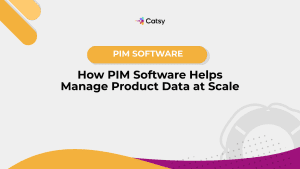
Table of Contents
- Charting Your Course: Understanding Product Information Management
- The Stormy Seas of Product Data Challenges
- Setting Sail with PIM Software: Core Features and Capabilities
- Navigating Scale and Multi-Channel Distribution
- Crew Coordination: Workflow Management and Analytics
- Choosing Your Vessel: Selecting the Right PIM Solution
What You Will Learn
- How Product Information Management (PIM) software serves as your digital compass for product data organization
- The specific challenges that arise when managing product information at enterprise scale
- Core PIM features that streamline data management across thousands of products
- Strategies for maintaining data quality and consistency across multiple sales channels
- Workflow automation techniques that reduce manual errors and improve team efficiency
- Methods for measuring PIM success and return on investment
- Key criteria for selecting the right PIM solution for your business needs
- Best practices for implementing PIM software in complex organizational structures
In this Article
1. Charting Your Course: Understanding Product Information Management
In the ocean of e-commerce, product data is the wind in your sails. Just as a ship’s captain relies on charts and navigational tools, today’s businesses need robust product information management (PIM) software to navigate the rough waters of digital commerce.
Product Information Management represents a strategic approach to collection, management, and distribution of data – no matter how many channels you sell across. Think of it as your digital lighthouse; it provides a central beacon that guides your product data.
At its core, PIM software is a single source of truth for all your product related information. That may include basics like names and prices, but it also includes more complex information. Your tech specs, marketing copy, and regulatory compliance information all live within your PIM.
The importance of effective product data management can’t be overstated in today’s marketplace. Research shows that inconsistent or inaccurate product information impacts customer trust directly. In fact, 87 percent of consumers say they would not purchase from a retailer a second time if during their first experience they encountered incorrect data.
Furthermore, businesses with centralized product information management systems report up to 25 percent improvement in time-to-market for new products and a 30 percent reduction in product information errors across channels.
a. The Evolution of Product Data Management
The journey from manual catalog to PIM mirrors the evolution from celestial navigation to GPS technology. In the early days of commerce, businesses used spreadsheets, paper catalogs, and disconnected databases to manage product data.
As businesses expanded their reach across multiple channels, the complexity of data management grew. Each channel (think: mobile applications and e-commerce platforms) often required different formats, specs, and levels of detail. This created inconsistencies that threatened to sink marketing efforts.
Today, PIM software has emerged as the navigational solution. It offers businesses a way to stay on course while still adapting to the unique requirements of each sales channel. PIM systems serve as the command center for product information, orchestrating data flows with the precision of a seasoned harbor master.
b. The Strategic Value of Centralized Product Information
When you centralize your product information through a PIM software, you gain strategic advantages that extend well beyond basic data organization. Centralized product management creates operational efficiencies that ripple throughout your entire organization.
First, centralization eliminates data silos. When your product information lives in multiple disconnected systems, your updates can be problematic! Without a PIM, you’ll find the need for complex coordination across platforms and departments. PIM breaks those barriers. Now, a single update propagates across your systems and channels with virtually no effort.
Second, centralized product data allows for better decision making. Marketing teams can quickly access the most current product specs, sales teams can quote with confidence, and customer service reps can provide definitive guidance to consumers.
This transparency creates a more agile organization that’s capable of responding quickly to market opportunities and customer needs.
Make Catsy DAM and PIM Software an Extension of Your Team
Book a Free Demo2. The Stormy Seas of Product Data Challenges
Managing product information at scale presents challenges that can quickly overwhelm businesses unprepared for the complexity. These challenges require both strategic planning and the right tools to weather the storm successfully.
The most pressing challenge you may face as a business is data inconsistency across your channels. Picture a fleet of ships. One vessel lists “Navy Blue Cotton Shirt, Size Large” on its manifest. Another describes an identical item as “Dark Blue 100% Cotton Shirt, L.” As you can imagine, these inconsistencies create confusion!
Data quality issues compound as your catalog expands. Manual data entry introduces errors and disparate systems lack validation rules to catch them. A single typo can result in inventory discrepancies, failed orders, and disappointed customers!
When multiplied across thousands of products and dozens of channels, these seemingly minor errors can create significant operational turbulence.
a. The Multiplication Effect of Scale
As you scale, each product data is amplified exponentially. Think about it: a company with 100 SKUs across three channels faces 300 potential points of inconsistency! When you scale that same business to 10,000 SKUs across 15 channels, you’re looking at navigating 150,000 potential failure points.
Let’s consider product attribute management for a moment. A global retailer who sells electronics may need to display tech specs in both metric and imperial measurements. The same product may require different safety certifications, compliance statements, and even product names!
Seasonal updates can also cause problems when you scale. A fashion retailer launching a new collection must coordinate updates across hundreds or thousands of products simultaneously. Updated descriptions, price adjustments, and availability must be updated in real time. Without centralized management, this becomes a nightmare!
b. The Multi-Channel Maze
Modern commerce demands that your business be visible across an ever-growing number of channels. Each of these channels present their own requirements for how data is uploaded and displayed.
Your own e-commerce website might allow unlimited product description length, while Amazon restricts descriptions to specific character counts. Instagram Shopping requires square product images, while Google Shopping prefers different aspect ratios.
Without proper management tools, your teams may feel that there’s no choice but to manage each channel’s data separately. This approach just isn’t sustainable, though, and will lead to version control issues and inconsistencies.
The challenge extends beyond formatting requirements! E-commerce is complex. SEO requires different keywords than social media marketing. Marketplace listings need different pricing strategies than D2C sales portals. So you see? Each channel optimization creates additional data variants to track and update.
3. Setting Sail with PIM Software: Core Features and Capabilities
Enter PIM. Modern product information management software provides the navigational instruments you need to chart a course through your complex data management. PIM offers integrated tools that were designed to handle every aspect of data management with efficiency and precision.
At the heart of any effective PIM is its centralized data repository. This repository accepts data, processes it, then distributes your information to various destinations. Unlike spreadsheets and other databases, PIM is specifically designed to support complex data. Hierarchical product relationships, variant management, and complex attribute structures are all handled with ease.
The data modeling capabilities in your PIM software enable you to define precisely how your products should be structured. Each of your product categories requires different data attributes, and your PIM allows that. Product information management allows you to create templates for anything you need, whether that be size charts, tech specs, or style details.
a. Data Quality and Validation Systems
An advanced PIM platform will include sophisticated tools that will be your automated quality inspectors. These systems can automatically validate the completeness of your required fields, can make sure your data meets formatting requirements, and can flag potential issues for review.
You can customize your validation rules to suit your needs! For instance, one rule may require that each of your electronics products include energy efficiency ratings, or that your sporting goods list safety certification numbers. These automated checks will prevent incomplete or inaccurate info from reaching your customers – all while reducing manual effort!
Data enrichment capabilities allow your PIM to automatically enhance your information, too. It uses external data sources and artificial intelligence to automatically generate content. For instance, your PIM may create SEO-friendly descriptions, generate technical specifications for a product, or suggest relevant product categories based on your SKU’s existing attributes.
b. Digital Asset Management Integration
A modern PIM system doesn’t just handle your text-based product information, but extends its capabilities to digital asset management. Your product images, videos, documentation and more are all treated as integral components of your product information. They simply aren’t separate.
This integration ensures that your visuals are correctly linked to the associated products, across each of your catalogs. When a product is discontinued, the associated pictures are automatically flagged for removal. Similarly, when new variants are created your PIM will prompt your teams to upload the corresponding assets. This prevents the commonly encountered orphaned images that can impact your customers.
Advanced DAM within PIM platforms includes automatic format optimization for each of your channels. For instance, a single high-res image can be resized, compressed, and formatted to meet the requirements of your desired platform. This automation eliminates hours of manual processes.
4. Navigating Scale and Multi-Channel Distribution
Scaling product information management is like traveling from a small local harbor to an international port. As you scale from dozens to thousands of SKUs, the infrastructure that was once working is now obsolete. PIM software addresses these scaling challenges through its architecture and through intelligent automation.
Modern PIMs are built on scalable cloud infrastructure, and can therefore handle massive amounts of data! This means that your business won’t need to worry about outgrowing your PIM system as you scale. Your software will automatically allocate additional resources during peak usage periods to ensure consistent performance.
Today’s e-commerce ecosystem is quite interconnected! For that reason, businesses must maintain a solid presence across multiple platforms at the same time. Each channel represents a unique destination with specific requirements, customs, and expectations. Despite this, your data must remain accurate. PIM enables this.
a. Automated Data Processing and Multi-Channel Optimization
As you scale, you’ll find that automation becomes critical. PIM software includes workflow engines that will automatically route your data through the approval process. When updates are required, you will receive a notification. Meanwhile, your PIM will run routine maintenance tasks – without your input.
Batch processing allows your business to make sweeping changes, even across a large catalog. This may include anything from pricing updates to the addition of attributes to your products.
PIM software orchestrates the distribution of product information across diverse channels, all while adapting to each channel’s unique requirements. A single product description might be optimized for search engines, condensed for mobile apps, or formatted with hashtags for your social platforms.
For instance, when a supplier updates its prices, the PIM can automatically import those new prices, and business rules are automatically applied for markup calculations. Any prices that fall outside the acceptable ranges you’ve set will be flagged for review. Finally, the approved price changes will be pushed to each of your channels at a specific date and time!
This entire process occurs without manual intervention, freeing you and your crew to focus on strategic activities … not routine data maintenance.
b. API Integration and Marketplace Management
Today’s PIM solutions are built with API-first architectures. What that means is the enablement of seamless integration with just about any e-commerce platform. Think of APIs as universal translations systems – they allow different software programs to communicate effectively. API-first architecture means your data will flow to each of your connected channels within seconds of approval.
Major marketplaces like Amazon and eBay each have unique requirements for data structure and optimization. PIM software includes specialized features that understand each of these platforms’ requirements. For Amazon, this may include automatic title optimization or compliance checks for category-specific requirements.
Your customers want fast search, filtering, and data retrieval, and performance optimization makes this possible. Indexing strategies create optimized search structures. Caching mechanisms store your most-accessed data in fast-access memory locations. In the end, your customer can find precisely what he’s looking for – fast.
5. Crew Coordination: Workflow Management and Analytics
When you’re managing data at scale, you need coordinated effort across your teams. PIM software provides both the communication and the coordination to make this possible.
Just as a ship’s captain will monitor navigational instruments, your PIM requires ongoing measurement, too. PIM software provides comprehensive analytics to help you understand whether your data is performing. If not, you can use that data to set a course for success.
a. Collaborative Workflows and Quality Management
Workflow management with PIM defines clear processes for how your data moves through your company. These workflows can automatically route new launches through approvals. For example, legal teams can review compliance information, and your marketing teams can approve descriptions. Each step is tracked and monitored, giving you visibility into areas needing improvement.
Role-based access is a fantastic tool! Your team members can access only the data that’s relevant to their job description. Your marketing team members, for example, can edit product descriptions but can’t modify prices. Or your sales teams may want to view tech specs, but can only update inventory projections. Having these controls in place maintains the integrity of your data while your teams fulfill their roles.
Data quality metrics are your fundamental performance indicators. PIM platforms automatically track the completeness and consistency of the data you’ve provided. Automated data validation and quality management features prevent errors from reaching customers while reducing manual oversight requirements.
b. Performance Analytics and ROI Measurement
Channel performance analytics will give you insight into how your product data is translating into business results. That may include tracking how your product descriptions perform, or how your different image styles impact your click-through rates. Understanding these relationships helps you optimize your data to maximize your profits.
Measuring your ROI from PIM software requires both cost savings and revenue improvement tracking. Your cost savings may include fewer customer service inquiries, decreased returns, or even a reduction of time spent on manual entry. Faster time to market, improved visibility, and increased consumer confidence are a few causes for improvement.
Advanced PIMs use predictive analytics to help you understand your future business needs. Machine learning algorithms look at your past performance data and identify patterns and trends. And task management features ensure that your time-sensitive updates are given priority.
6. Choosing Your Vessel: Selecting the Right PIM Solution
Choosing the right PIM is like choosing a vessel for an ocean voyage. The decision will impact each aspect of your journey. The wrong choice can leave you struggling, while the correct choice can mean smooth sailing to success.
Your first consideration as you choose a PIM should be an honest assessment of your current situation. Are you managing 500 SKUs, with plans to grow to 1,000? Do you already have 50,000 but are seeking to aggressively scale? Understanding your requirements helps you narrow the field and choose a solution that’s right for you.
Integration requirements are decisive in PIM selection. The solution you choose should seamlessly connect with your existing e-commerce platform, ERP system, automation tools, and specialized software.
a. Cloud vs. On-Premise and Deployment Considerations
Most modern PIM systems are cloud-based. That offers significant advantages in scalability, maintenance, and feature updates. You’ll benefit from auto-update features, robust security, and impressive scalability. This is invaluable to businesses that need flexibility without the overhead of a complex IT infrastructure.
That said, some organizations require (or prefer) on-site deployment. This could be due to security requirements, compliance regulations, or the need to integrate with legacy systems. On-site solutions offer you a great deal of control but they require significant IT resources. Hybrid deployments provide a middle ground, combining the benefits of cloud-based and on-premise controls.
The choice you make will depend on your business! Your tech capabilities, regulatory environment, and growth strategy will all play a role in your selection. As you shop, consider your data sovereignty requirements, your existing IT setup, and your team’s ability to manage maintenance.
b. Vendor Evaluation and Implementation Planning
The successful implementation of a PIM begins well before you deploy the software! You’ll need to evaluate vendors and plan your implementation, first!
Vendor evaluation should focus on both current capabilities and future possibilities. The PIM market is evolving rapidly, and new features emerge regularly. Choose vendors with a strong momentum in development. Consider, too, financial stability, customer support, and the vendor’s experience with your industry.
As you plan for implementation, you’ll need to account for a few factors. Your data migration complexity is one. Your user training requirements and change management needs are other considerations.
Migrating from a legacy system can often prove more challenging than you’d originally thought. That’s especially true if you’re dealing with legacy data formats or incomplete information. Have a little grace – allow yourself and your teams ample time to clean, validate, and test your data before you go live.
Metrics to measure your success should be established early! These might include improvements in your data quality scores or reductions in time to market. Increases in channel per performance and decreases in manual effort are other considerations.
Clear success criteria from go will help you maintain your project momentum and justify a continued investment in PIM capabilities.
Key Takeaways
Strategic Foundation:
PIM software is the navigational foundation for e-commerce. It provides centralized control and consistency across each of your channels, ensuring that accurate product information reaches your customers, no matter where they find you.
Scalability Solution:
Managing product information at scale increases complexity exponentially. This requires tools that were built for the job. Manual processes can quickly become overwhelming but a PIM provides the automation you need to stay in control.
Quality Assurance:
Automated data validation and quality management features prevent errors from reaching your consumer, and these features take manual workloads off your team, too. This becomes increasingly valuable as your catalog grows.
Multi-Channel Mastery:
Modern commerce demands consistency across numerous channels, and each of these channels has unique requirements. Your PIM can “translate” your data in a way that’s appropriate for each channel, ensuring that your customer sees the same data no matter where they shop.
Collaborative Efficiency:
Effective product information management requires that your stakeholders coordinate efforts. PIM platforms provide workflow management, access controls, and communication tools to do just this.
Measurable Impact:
Successful PIM implementation requires ongoing measurement and optimization. PIM analytics provide you with the data you need to make informed business decisions. Reports are based on performance, and are helpful in charting a course for continuous improvement.
Strategic Investment:
Choosing the PIM solution that’s right for your business requires consideration of your current and future needs and your integration requirements. The choice will impact each aspect of your data management, so the platform you choose should align with your long-term goals.
Want more tips, tutorials, and insights on product content and e-commerce operations?
Stay connected. We post regularly to help brands like yours scale smarter.
Are You Ready To streamline your product content management?

Frequently Asked Questions
PIM implementation timelines will vary based on your catalog size, your data quality, and your requirements for integration. Simple implementations may take three to six months, while complex enterprise deployments may take 12 to 18.
Key factors that affect your timeline may include data migration complexity, number of required integrations, customization needs, and the internal resources you have available internally for the project.
Modern PIM platforms are great at managing product relationships and hierarchies using sophisticated data modeling. Parent-child relationships let you manage shared attributes at a parent level. Meanwhile, you can still maintain variant-specific info for your individual SKUs.
Taking this approach will significantly reduce your data entry effort – and errors – across your product families. Advanced PIMs can handle multi-level hierarchies, bundled products, and complex variant structures that are common in industries like fashion and electronics.
Absolutely! Integration capabilities are a fundamental strength of modern PIM systems! Most will offer pre-built connectors for sites like eBay or Shopify, for ERP systems, and for marketing tools. API-first architectures enable custom integrations.
The key is to ensure that your chosen PIM specifically supports your legacy tech stack and that it can handle the data sync requirements of your business.
PIM software was designed with the business user in mind. There’s not a high level of technical expertise required to use a PIM like Catsy, so your teams can benefit with minimal tech training. Most platforms feature interfaces for tasks like data entry, workflow management, and reporting.
However, the initial setup, integration configuration, and advanced customization may require a bit more technical prowess. Many businesses find success with a hybrid approach. Business users handle the day to day operations while IT teams manage configuration.
PIM software pricing models vary by vendor. However, most will use a subscription-based structure based on a number of factors. Your catalog size, organizational size, and data volume all come into play.
An entry-level solution may start at around $500-2,000 monthly while enterprise solutions may cost $10,000 monthly or more.
Consider total cost of ownership including implementation services, training, and ongoing support when evaluating options, but also consider your return on investment. Many vendors offer tiered pricing that scales with your business growth.
Data migration is a critical component of PIM implementation, and it requires careful planning and execution. In most cases, implementation means analyzing existing data, mapping that data to the new PIM, and performing test migrations before you go live.
Sometimes, quality data migration requires more time and effort than you’d anticipated? That’s especially true for those consolidating information. Plan for data cleanup prior to implementation, and allow ample time for validation and testing.
ROI timelines are unique to your business. They depend upon your implementation complexity as well as the extent of your existing inefficiencies. Businesses often see the initial benefits of a PIM within 6 to 12 months, taking the form of reduced manual effort, improved data quality, and faster product launches.
More significant ROI typically emerges over 12-24 months as teams fully adopt the system and realize benefits like increased channel performance, reduced customer service inquiries, and improved operational efficiency.
Set realistic expectations and measure both the cost savings and the revenue improvements that can be attributed to your PIM.
Subscribe For More Content
Sign up for monthly tips on how to drive revenue with product content.




